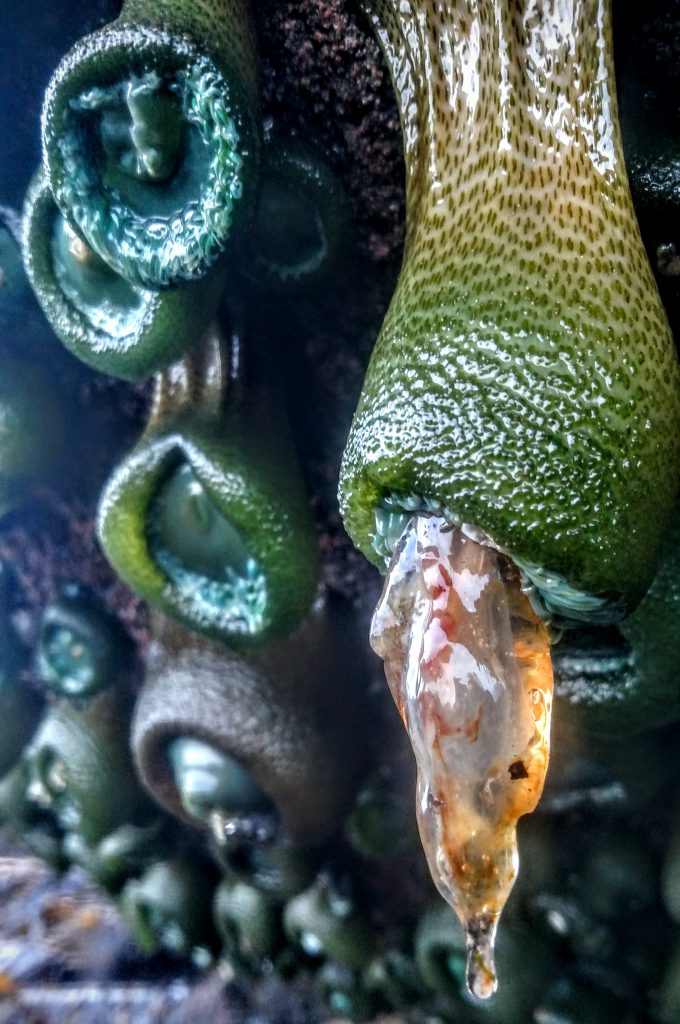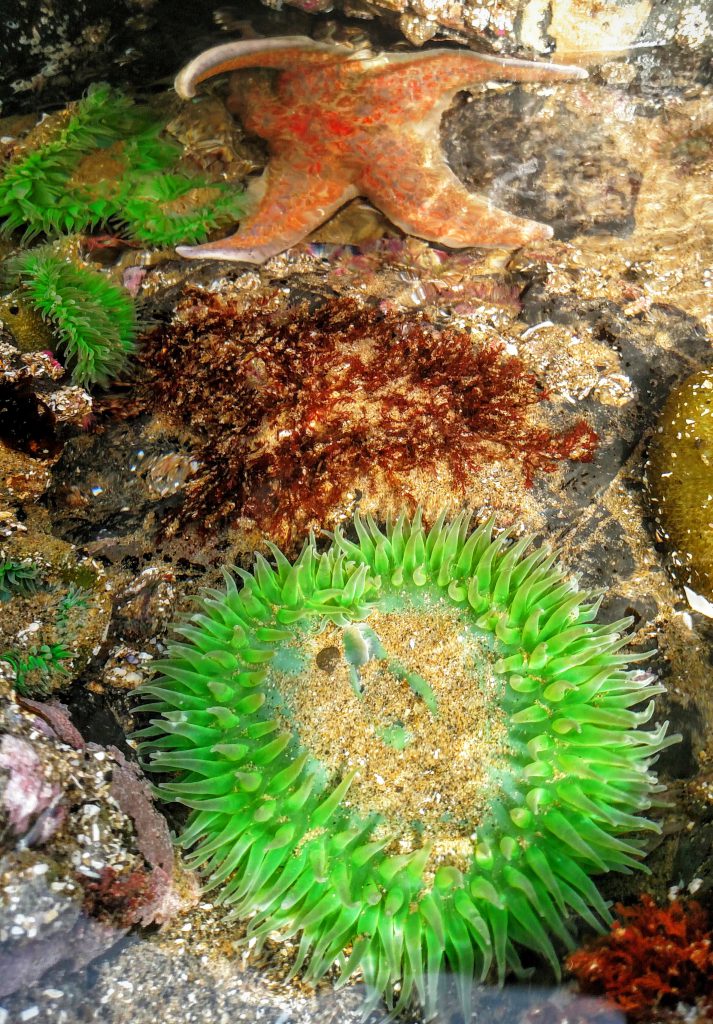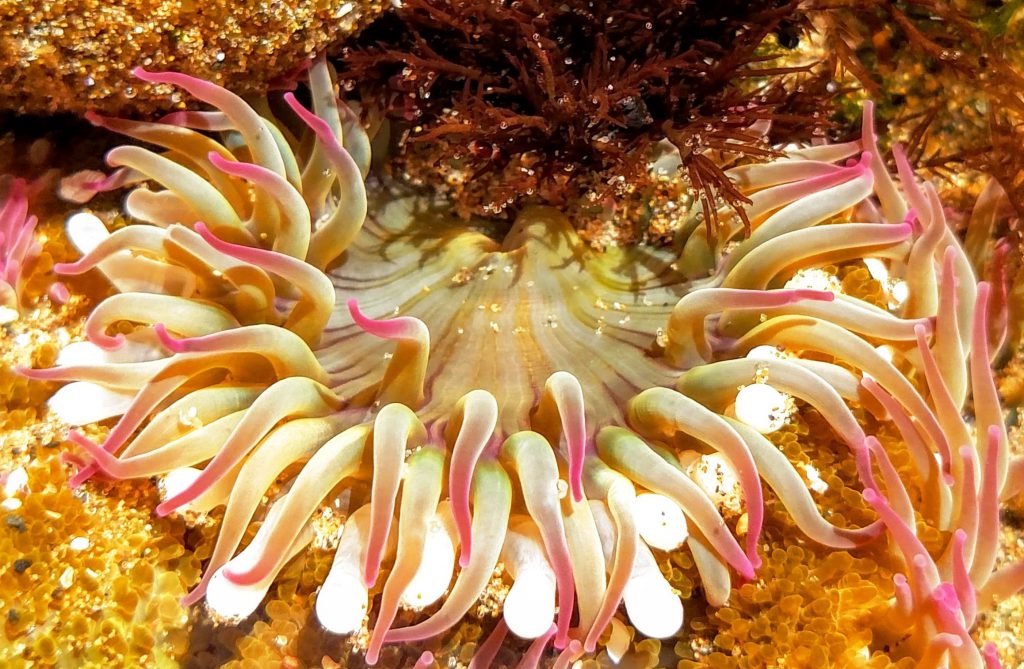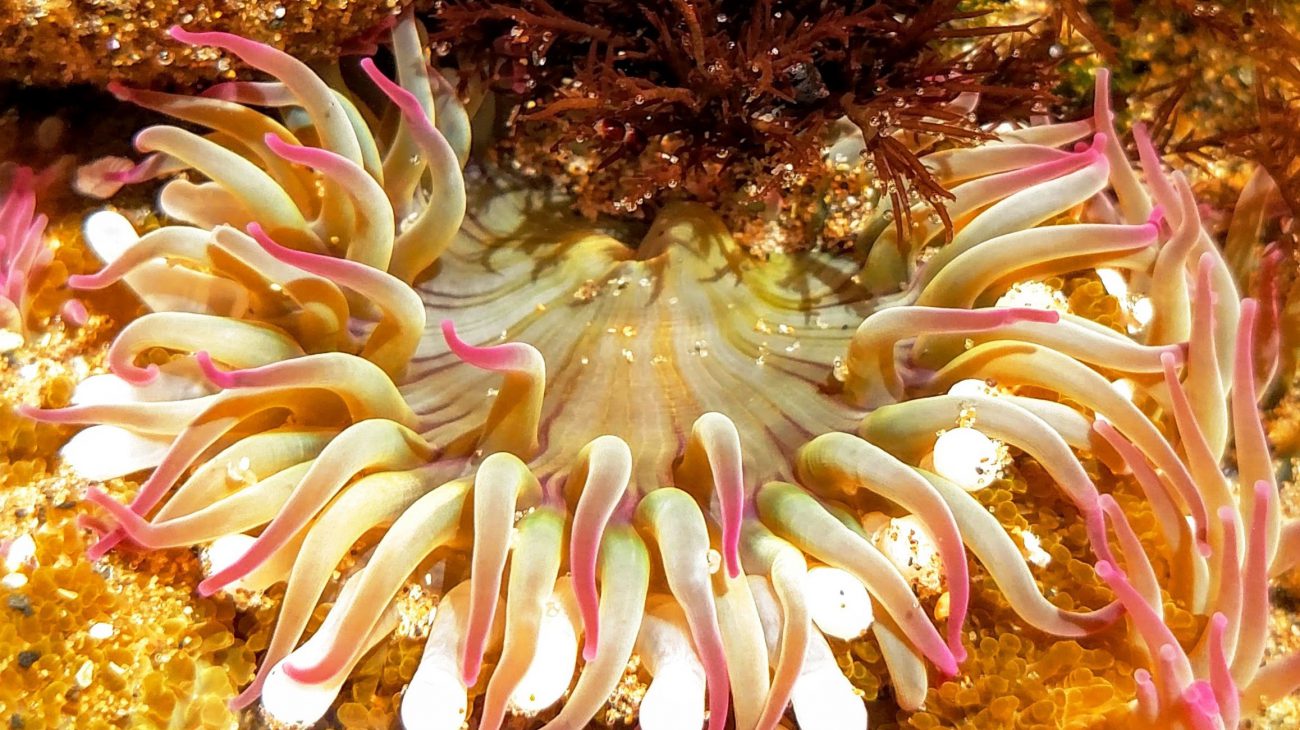Sea anemones dot the tidepools and rocky reefs in and around Oregon’s marine reserves, and look more analogous to flowering plants than the predatory animals that they actually are. SCUBA surveys shed light on 8 species that have subtidal populations in the reserves, with the most common being the giant plumose anemone.
We invited guest author, filmmaker and photographer, Stephen Grace, to share his fascinating perspective on sea anemones in Oregon.
By Stephen Grace – author, filmmaker and photographer
The sea anemones that paint Pacific Northwest tidepools with color look like tranquil flowers but are, in fact, predatory animals. Cousins of jellyfish, coral, and siphonophores like the Portuguese man o’ war, anemones are in a group of marine creatures that have tentacles packed with poisonous stinging cells to paralyze and kill their prey. Deadly beauties of the intertidal zone, anemones not only eat animals. They also battle for territory, even engaging in wars with rival colonies over contested terrain.
As large as a tea saucer and sometimes growing to nearly the size of a dinner plate, the giant green anemone (Anthopleura xanthogrammica) will devour almost any creature careless enough to stray too close to its sticky tentacles, or to tumble into its emerald clutches. The tentacles fold in toward the anemone’s mouth; the mouth gapes open and protrudes toward the paralyzed victim. If a giant green anemone grew six feet wide and lurked beneath pools where people play, Stephen King could not create a more horrifying scenario.

Giant green anemone eating a jellyfish (Photo by Stephen Grace)
Anemones can release their grip on a hard surface and move their pedal discs like ponderous feet, creeping their way across a rock. Occasionally they detach themselves and float away to reattach to a new surface, but generally these predators remain anchored in place. Giant green anemones often station themselves beneath mussel beds bashed by waves; the anemones devour bivalves knocked loose that fall into their lethal grasp. Urchins and snails that tumble downward also become a meal. Crabs that brush an anemone’s sticky tentacles are grabbed and eaten, and fish that swim too close are imprisoned in a deadly embrace. Giant green anemones even eat birds. Young cormorants and gulls that tumble into pools below their nests have been devoured by these stationary assassins.
Whatever hard animal parts an anemone can’t digest, such as bones, beaks, shells, and spines, are expelled through the opening at the anemone’s center. This orifice is both mouth and anus. Though odd to us, this multitask plumbing serves the anemone well. Hermit crabs have no complaints about this anatomical curiosity, either. An empty snail shell spat out of an anemone’s mouth-anus, after the mollusk inhabitant has been digested by the anemone, makes a choice home for a hermit crab. The blue-banded hermit crab performs a dangerous dance, walking across the tentacles and mouth of a giant green anemone without being eaten as it waits for a turban snail shell to be ejected.
The giant green anemone uses its stinging cells for defense as well as for feeding. Anemones eat some species of snails; some snail species eat anemones. Wentletrap, from a Dutch word meaning “spiral staircase,” is a family of snails with beautifully spiraled shells that seem sculpted of porcelain. But these elegant mollusks are anemone killers. Some wentletraps snip the anemone’s tentacles; others spear a long proboscis, or feeding tube, into the anemone’s soft column. An anemone might be digesting a wentletrap relative, like a black turban snail, while the anemone is attacked by the wentletrap. Every pool at the ocean’s edge contains a complicated world of competition and predation.
The shaggy mouse nudibranch is another enemy of the anemone. This sea slug looks like a little bedraggled rodent when stranded out of the water. The shaggy mouse is immune to an anemone’s poison and attacks the creature underwater, dining on the anemone’s stinging tentacles. The leather sea star is another anemone predator. Additionally, some sea spider species feast on anemone flesh. Though not true spiders, these arthropods are part of a tangled web of creatures eating and being eaten along the water’s edge. There are no pacifists in the ferociously competitive tidepools.

Giant green anemone and leather sea star (Photo by Stephen Grace)
It’s not all cutthroat competition between the changing tides, however. Giant green anemones have a symbiotic relationship with algae. Algae that live inside the anemones are protected from grazers like snails. In exchange for being safely housed, the photosynthesizing algae provide their hosts with carbohydrates, contributing a significant portion of the calories to an anemone’s diet.
The brilliant color of the giant green anemone is attributed both to the algae it hosts and to a sunscreen it produces. Green fluorescent protein prevents solar radiation from damaging the anemone’s body by absorbing ultraviolet light and emitting lower-energy green light. This fluorescence contributes to the giant green anemone’s dazzling hue.
The color of giant green anemones varies with exposure to sunlight. Anemones lurking below shadowy ledges and hidden in caves can be as grey as ghosts, while not far from these pale zombies, which are smaller and more sickly than their colorful counterparts, robust anemones bask in direct sunlight. Anemones that are showered with light shine fluorescent green, as if painted by an artist on magic mushrooms.
An anemone that withdraws its tentacles when stranded above the water is transformed from a tidepool beauty into a repulsive beast. People who wax lyrical about an anemone beneath the sea wrinkle their faces in disgust when the same creature becomes a blob dangling from a rock. But what looks repulsive to us is an adaptation that allows the anemone to avoid drying out. The less surface area that is exposed to air and sun, the more moisture the squishy creature retains when the tide is out. The anemone pulls its pretty oral disk and tentacles into its column, holding a bit of the sea inside its sagging body until the tide returns.
The symbiosis between giant green anemones and algae, though not as showy as the famous partnership between anemones and clown fish, runs deep. Like nearly all other animals, anemones inhale oxygen and exhale carbon dioxide. The algae inside an anemone’s body combine water and sunlight with the carbon dioxide exhaled by the anemone to create carbohydrates, and these sugars feed the anemone. In return, a sea anemone swivels its body toward the sun, providing the algae inside its cells with light for photosynthesis.
Algae, in turn, release oxygen as a byproduct of photosynthesis. The oxygen is inhaled by the anemone to fuel its respiration, and this oxygen-powered respiration releases the energy stored in carbohydrates—which were produced by the algae and consumed by the anemone. It’s hard to imagine a more mutually beneficial partnership.
The giant green anemone may also help humans. A toxic compound that the animal produces to defend itself from predators acts as a potent heart stimulant in vertebrates. Medical researchers are studying this compound, anthopleurin, for its potential to treat patients with heart failure and liver injury.
Anemones might even help scientists solve the riddle of eternal youth. Their powers of regeneration are remarkable. If an anemone is torn apart, each part will heal and become a complete animal. Anemones have been documented to live one hundred years, but scientists believe they can live much longer. Some researchers posit that these methuselahs of the tidepools are, in fact, functionally immortal. That is to say, as long as anemones are not poisoned or eaten, these creatures with a primitive nervous system but no brain will go on living, showing no signs of the cellular degeneration that kills people. No tumors, no cancer, no death: somehow anemones avoid these human plagues of aging. If we don’t kill off anemones first by poisoning their waters, these deadly beauties may offer us the key to immortality.
Aggregating Anenome
The aggregating anemone (Anthopleura elegantissima) covers rocky surfaces by cloning itself. A pioneer anemone founds a new colony by dividing in half. It stretches like taffy, pulling its body in opposite directions until it breaks into two pieces. Each half regenerates into a complete anemone with an identical copy of DNA. One anemone becomes two identical anemones, two become four, and so on, until clones blanket a surface.

Aggregating anemone (Photo by Stephen Grace)
Multiple copies of one genetic individual help ensure survival amid the violence of the intertidal zone. Flood and drought cycle daily, salinity and temperature fluctuate wildly, and the creatures that inhabit this brutal world are battered by waves and scorched by sun as they evade predators and struggle for scarce space and limited food.
“Strength in numbers” could be the motto of an aggregating anemone that clones itself into hundreds of copies. This redundancy is a neat survival trick, and also makes great fodder for science fiction. Imagine you could emulate an aggregating anemone and clone multiple copies of yourself. If all but one of the cloned copies perished, and the original you was also killed, would you still be alive? For the aggregating anemone, the answer is a resounding yes.
Watching anemones clone themselves is like seeing cells divide under a microscope, but the process stretches over a span of many hours and days. There is drama in an anemone’s world, but the action unfolds on a timescale that requires patience—or time-lapse photography.
Aggregating anemones that are genetically different get along like Hatfields and McCoys. When spreading colonies of clones collide, warrior anemones at the borders react. The warriors triple their body length as they reach toward foreign clones encroaching on their space, and the warriors deploy armaments, extending stout battle clubs that fire barrages of poisoned missiles at the colony’s rivals.
As anemones sustain damage in these territorial skirmishes, they loosen their grip on the hard surface and slink away from their attackers. In the aftermath of a clone war, bare rock emerges between colonies. These no-clone-zones are clearly visible as strips of bare rock an inch or two wide between densely packed colonies that otherwise completely cover a rocky surface.
The clones in an aggregating anemone colony are genetically identical, yet they take on specialized roles. Surrounded by warrior clones, the reproductive clones in the colony’s center reproduce sexually. Each colony is composed of either all male clones or all female clones. These reproductive clones broadcast eggs or sperm, depending on their sex, and the gametes mix in the water.
The reproductive clones of two colonies that are mortal enemies battling like Montagues and Capulets can, like star-crossed lovers, blend their genes and create larval anemones. These spawn of warring nations move through the water to settle on rocky frontiers, and they create new colonies of their own, carrying forward the endless cycle of cloning, sex, and combat beneath the sea.
Some clones turn into scouts, venturing into unknown territory beyond the colony’s borders. When a scout returns, its colony can detect if their explorer was attacked during its journey into uncharted territory. If the scout was stung by warriors of another colony, the scout’s clonemates can sense that a rival colony is nearby.
When I learned about clone wars, my interest in the intertidal zone exploded. After reading about aggregating anemones, I explored the ocean’s edge for evidence of battle. When I saw a demilitarized zone of unoccupied rock separating two competing colonies, my mind was blown wide open. I grew determined to see enemy anemones in action.
After a few weeks of searching tidepools, I spotted warriors extending their white acrorhagi, the war clubs they inflate when fighting rival colonies. When I stooped down to stare into the tidepool that sheltered these combative creatures, I witnessed a war taking place on multiple fronts as colonies blanketing a boulder battled each other for territorial supremacy. Anemone nations rose and fell that day as I slithered on my belly across sand to watch this Game of Thrones play out beneath the surface of the pool. I’ve been hooked on the intertidal zone ever since.
Not all of the aggregating anemone’s adaptations are related to combating rivals for space. To protect itself from ultraviolet radiation, the creature has adhesive cells on the outside of its body that gather bits of shell and other debris from the seawater. On the rare occasion that the sun shines on the Oregon Coast, the anemone is prepared. The material covering its body reflects the sun’s rays, preventing this sea creature from drying out: anemone sunscreen.
Sand burial is a fact of life in the intertidal zone. Winter storms strip beaches down to bare boulders and cobbles; gentle spring and summer waves send the sand back to shore, burying anemones and other animals attached to rocks under several feet of sediment. Giant green anemones and aggregating anemones have adapted to this regular burial routine by evolving the ability to live off stored glycogen when they can’t feed during prolonged periods of entombment. When released from their sand prison, they spread their poisoned tentacles and resume feeding on prey and fluorescing in the sun.
Human inventiveness can seem feeble compared to the creative force of evolution through natural selection. When I was a kid I devoured science fiction. These days I don’t have time for imaginary stories because I’m too busy staring into tidepools, where I study lifeforms more bizarre than any creation conjured in the human imagination. Landscapes along Oregon’s shores can seem like scenes from other worlds. And there is nothing stranger in science fiction or fantasy than the real beings that live in the intertidal zone.
